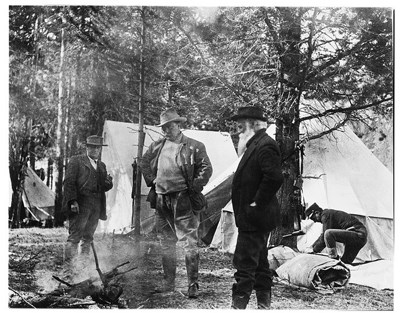Last updated: April 5, 2018
Article
Bison Bellows: Theodore Roosevelt

Photo courtesy of Keith Aune.
The plight of the American bison at the close of the 19th century inspired a whole new world view of natural resources. The decimation of the American bison from over 30-40 million down to nearly 1,000 by the late 19th century is a monumental story motivated by unrestrained resource exploitation for commercial purposes, the philosophy of manifest destiny and misguided U.S. Indian policy.
The winds of change were thrust upon American Bison and the America west after the formation of the United States in 1776. The Corp of Discovery explorations from 1803-1804 fueled the nation's appetite for expansion, and what followed from 1812-1860 appeared at the time to seal the destiny of the continent.
At the time of Theodore Roosevelt's birth in 1858 the fate of the American Bison, Native Americans and the natural wildlands upon which both depended had already been determined and the outlook was depressing to a nativist. During his childhood the United States survived a civil war that redefined principles of freedom and celebrated its 100th anniversary. As the country danced through the reconstruction period it exerted a domineering force throughout the continent and the world. During his early childhood there were about 10 people per square mile in the United States and about 17 bison per square mile. Upon his election to Vice-President 1900 there were 25 people per square mile and bison were nearly extinct.
Theodore Roosevelt was born into wealth and privilege that enabled him to explore nature and interpret his surrounding world from a more romantic viewpoint than most people living at that time. Perhaps as a consequence of his childhood explorations of nature and science, Theodore developed a fascination with American Bison that increased as he pursued his interests as hunter-conservationist and naturalist.
To Theodore Roosevelt the American Bison was a symbol of wild nature and western culture which he loved. Roosevelt was motivated by his quest to hunt the largest land mammal on the continent. He hunted and killed his first buffalo in 1883 at the age of 24 in Montana at Little Cannonball Creek. After the kill he danced enthusiastically around that buffalo to celebrate his success. Later on his second bison hunt in 1889 Theodore became more sanguine about the loss of the species, reflecting: "So for several minutes I watched the great beasts as they grazed...mixed with the eager excitement of the hunter was a certain half-melancholy feeling as I gazed on these bison, themselves part of the last remnant of a doomed and nearly vanished race. Few indeed are the men who now have or evermore shall have, the chance of seeing the mightiest of American beasts, in all his wild vigor, surrounded by the tremendous desolation of his far-off mountain home".
The American Bison Society (ABS) formed in New York on 1905 at the Bronx Zoo, where 14 people (13 men one woman) met to discuss the terrible plight of bison. William T. Hornaday served as the first president and Roosevelt was named honorary president. Roosevelt routinely used his position as U.S. President to help the New York Zoological Society and the American Bison Society secure land, procure buffalo and promote bison reintroduction projects. President Roosevelt even mentioned his concern for bison in his annual message to Congress in 1905. The first three premier bison restoration projects supported by President Roosevelt and the ABS included Wichita Mountains Reserve, Wind Cave National Park and the National Bison Range. As President, Theodore Roosevelt harnessed his passions into deliberate action and thereby changed the manifest destiny of the United States to ensure that there will always remain wild lands and wildlife, including the new National Mammal - the American bison.
